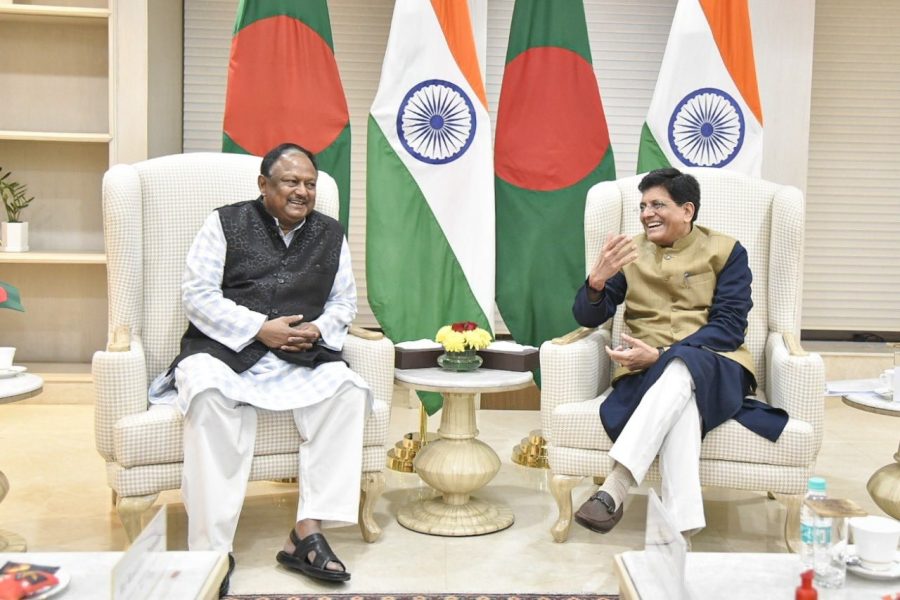
North-East pins hope on free trade with Bangladesh to boost its economy

India and Bangladesh are expected to firm up negotiations on the much-anticipated Comprehensive Economic Partnership Agreement (CEPA) during the India visit of the neighbouring country’s commerce minister Tipu Munishi. During Munshi’s two-day visit that started on December 22, the two countries will try to wrap up negotiations so that an agreement can be inked at the earliest.
A joint feasibility study conducted by the Bangladesh Foreign Trade Institute and the Indian Centre for Regional Trade found that the proposed deal may boost Bangladesh’s export earnings by 190 per cent and India’s by 188 per cent.
Also read: IndianOil-Beximco LPG venture in limbo amid India-Bangladesh bonhomie
North-East to benefit most
The biggest beneficiary of the proposed free trade deal, that calls for withdrawal of duties and lifting of restrictions on market access, is likely to be India’s North-East, trade bodies of the region feel.
Trade between the two countries was over $10 billion in FY22, with trade balance heavily tilted towards India. India’s imports from Bangladesh were below $2 billion as against exports of over $16 billion in 2021–22.
When it comes to the North-East, the scenario is completely opposite, said Debashis Nandi, the manager of Agartala-Akhaura integrated border checkpoint, the second-largest trading point along the India-Bangladesh border after Petrapole-Benapole land border in West Bengal.
“North-eastern states’ import from Bangladesh is much higher than their export to the neighbouring country. For example, in the 2022 fiscal, goods worth about Rs 650 crore were imported from Bangladesh through Agartala-Akhaura trading point. The volume of export was just about Rs 200 crore.” Nandi told The Federal.
Restrictions imposed by Bangladesh on exports of goods from the North-East and high import duty are the reasons he cited for the negative trade balance.
Bangladesh shares 1,880km of its border with the north-eastern region.
The trade potential
The North-East mainly exports coal, limestone, stone chips, and bamboo to Bangladesh. It has potential to export handloom and handicraft items, tea, rubber, floriculture items, processed fruits, spices, broom sticks et al, according to a study by the Federation of Indian Chambers of Commerce and Industry (FICCI).
Many of these potential items are however not enlisted in the tradable list of products.
Only 40 commodities are allowed to be exported from Agartala-Akhaura border in the northeastern state of Tripura, Nandi pointed out. Due to these restrictions, he said, informal trade is increasing as there is heavy demand in Bangladesh for certain products from the North-East.
“Tripura is the second-largest producer of rubber in India. But due to restrictions we are not able to export the item through Agartala-Akhaura border point though Bangladesh has a huge demand for rubber, which it mainly sources from Malaysia,” said Tushar Kanti Chakraborty, president of All Tripura Merchant’s Association (ATMA).
The ATMA and other trade bodies of the region had been repeatedly urging the Government of India to facilitate lifting of restrictions through bilateral discussions with Bangladesh, Chakraborty said.
Further, due to stiff duty charge by Bangladesh on products from India, exports of many of the 40-listed items become unviable, he added.
On average, imports from India are subjected to tariffs of about 20 per cent by Bangladesh.
All hopes on CEPA
“The CEPA, if implemented, will lower tariffs and enhance market access of products from north-eastern states to Bangladesh,” pointed out Mahavir Jain, the president of Guwahati-based Kamrup Chambers of Commerce.
Trade bodies privy to the findings of the Dhaka-Delhi joint feasibility study on CEPA also claim that the prospect of investment from Bangladesh to the North-East would increase following the agreement.
The proposed deal promises to go beyond the traditional free trade agreements to address issues such as investment, intellectual property rights and e-commerce.
“Facilitation of FDI from Bangladesh will be a big impetus for the capital-starved economy of the land-locked north-eastern region,” the ATMA president said. Though India is now more open to the FDI from Bangladesh, he said, there are still certain restrictions which need to be eased out to ensure capital flow in the region.
Prior government approval is mandatory for foreign direct investments from Bangladesh. Often it becomes very difficult for the insurgency-hit region to get the approval due to security reasons, sources said.
FDI from Bangladesh
The PRAN Group of Bangladesh set up a plant in Tripura’s Bodhjungnagar industrial growth centre a few years ago. The investment of around Rs 200 crore is the first FDI from Bangladesh to the North-East so far.
The PRAN, a household name in eastern and north-eastern India, is the food and beverages processing company that produces wide-range of food products, including juices, carbonated beverages, biscuits and dairy products.
Top Bangladeshi private power company, Summit Group, in July last year acquired a 23.5 per cent stake in the ONGC Tripura Power Company (OTPC) in July last year.
“We have apprised the NITI Aayog and concerned government ministries and authorities to facilitate flow of FDI from Bangladesh. Hopefully, the CEPA will ensure that,” Chakraborty added.
While welcoming the move by the two countries to formalize CEPA, Industries and Trade Fair Association of Assam (ITFFA) said a flight service with cargo facilities should be started between Guwahati and Dhaka, infrastructure and capacity of India-Bangladesh border trade point at Dawki in Meghalaya should be increased and there should be more business and trade exchanges between north-eastern states and Bangladesh.
Also read: US’ apparel import from Bangladesh jumps 53.54% to $6.64 billion in 2022
“At present apart from trade restrictions, infrastructure bottleneck is another major hurdle in pushing bilateral trade through Northeast,” pointed out ITFFA vice president Rajesh Das.
Infrastructure development is another area the CEPA will focus on, according to India’s commerce ministry.
In a statement, the ministry said CEPA will incorporate a variety of issues of mutual interest, including the development of railway infrastructure, port infrastructure, border haat, regional connectivity through multi-modal transportation.


